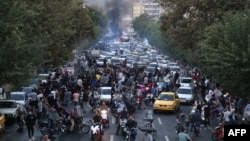
Welcome back to The Farda Briefing, an RFE/RL newsletter that tracks the key issues in Iran and explains why they matter.
I'm RFE/RL correspondent Golnaz Esfandiari. Here's what I’ve been following during the past week and what I’m watching for in the days ahead.
The Big Issue
Iran has faced more than two weeks of anti-government protests triggered by the death in police custody of 22-year-old Mahsa Amini.
Protesters, the majority of them young women and men, have called for the clerical establishment to be overthrown.
The authorities have reacted with force, killing at least 52 people and detaining more than 1,200, according to Amnesty International.
Despite the crackdown, scattered protests have been reported in major cities, including at universities. At Tehran's prestigious Sharif University, security forces were reported to have used tear gas to disperse demonstrators. Dozens of students were reported to have been detained.
Why It Matters: The protests are the most significant challenge to the authorities in years. But, at least for now, they do not threaten the survival of the regime.
There are no major divisions within the establishment or the security forces. There have been no major strikes like the ones that preceded the Islamic Revolution in 1979.
Even so, prominent rights advocate Nasrin Sotoudeh told TIME magazine that there is “a very real possibility of regime change.”
Supreme Leader Ayatollah Ali Khamenei has blamed the protests on the United States and Israel. Parliament speaker Mohammad Baqer Qalibaf accused those outside the country of inciting the protests with the aim of overthrowing the system.
What’s Next: Scattered protests are likely to continue despite the ongoing state crackdown. It's also likely that there will be more acts of civil disobedience, particularly in defiance of the hijab law.
In recent days, an increasing number of women have walked through the streets of Tehran and other major cities without their mandatory head scarves.
During an October 1 protest at Ferdowsi University in the holy city of Mashhad, young women removed and then waved their veils defiantly in the air while chanting, “Freedom, freedom,” according to an amateur video posted online.
Stories You Might Have Missed
• Iran has arrested a singer whose song about the ongoing protests in the country has gone viral, RFE/RL's Radio Farda has learned.
Shervin Hajipur composed his song using tweets by Iranians expressing their grievances against the clerical establishment in the aftermath of Amini’s death. Hajipur’s song, For, has been sung at protests and from rooftops during the night.
Hajipur was reportedly released on bail on October 4. It is unclear what charges were brought against him. Before it was removed from Instagram on September 29, his song had garnered more than 40 million views
• Former lawmaker and women’s rights advocate Faezeh Hashemi has been arrested and accused by state media of encouraging the anti-government protests.
Just days before her arrest, Hashemi, the outspoken daughter of former President Akbar Hashemi Rafsanjani, expressed support for the protesters while accusing the authorities of having a Taliban-like view of women.
Hashemi said that the authorities refer to the protests that have rocked the Islamic republic as “riots” and “sedition” in order to suppress them.
“What [authorities] want to convey is that these are not protests, they’re riots, but in fact they are protests,” Hashemi said in an audio recording obtained by Radio Farda.
What We're Watching
Iran has allowed detained 85-year-old Iranian-American Baqer Namazi to leave the country to receive medical treatment abroad while his son, businessman Siamak Namazi, was released on furlough after being jailed since 2015.
Baqer Namazi, a retired UNICEF official, was detained in 2016 after traveling to Iran to seek his son's release. Both were convicted of espionage and sentenced to 10 years in prison. Washington has dismissed the charges against the men as baseless.
Why It Matters: The release of the Namazis is a rare concession by the Islamic republic, which has long been accused of using detained foreign and dual nationals as pawns to gain leverage in its dealings with Western countries.
It is unclear if Siamak Namazi’s one-week furlough will lead to his full release. It is also unclear if the release of the Namazis could lead to the release of other U.S. citizens detained in Iran.
Iranian state media claimed that, in return for releasing the Namazis, Washington would release billions of dollars of Iran's frozen assets held by the United States. Washington said reports linking the unfreezing of Iranian funds to the release of the Namazis were “categorically false.”
That’s all from me for now. Don’t forget to send me any questions, comments, or tips that you have.
Until next time,
Golnaz Esfandiari
If you enjoyed this briefing and don't want to miss the next edition, subscribe here. It will be sent to your inbox every Wednesday.




